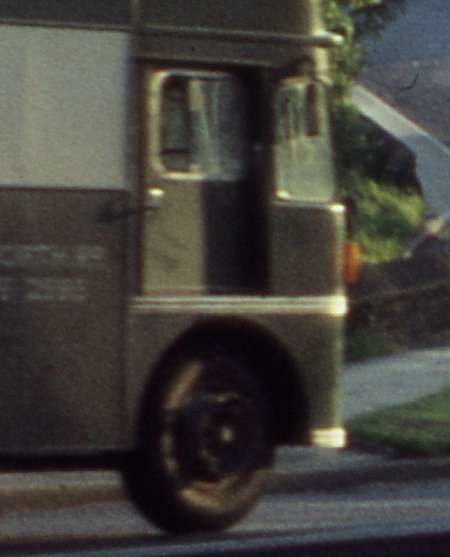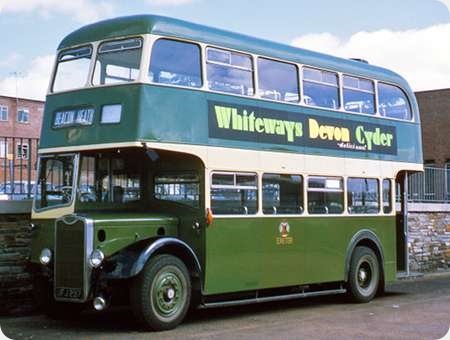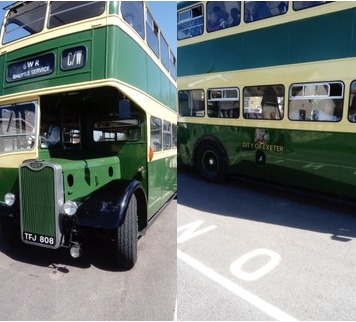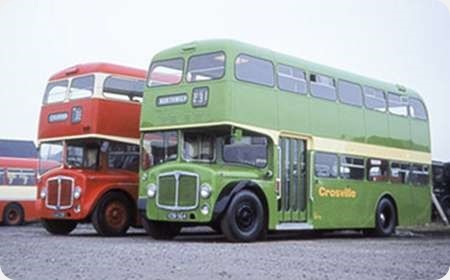
Crosville Motor Services
1963
AEC Renown 3B3RA
Park Royal H43/32F
Despite acquiring a good number of AEC Reliance single deckers during the late 1950’s and early 1960’s, North Western Road Car Co. had opted for the Dennis Loline for its double deck purchases during that period. It then perhaps came as a surprise when in late 1963 they received eighteen AEC Renowns (964-981, VDB 964-981) with Park Royal H43/32F bodies, followed by a further fifteen (115-129, AJA 115-129B) with H42/30F bodies in 1964.
However in 1972 the NWRCC depots and operations at Stockport, Oldham, Glossop, Altrincham and Urmston passed to the SELNEC PTE, a separate company – the SELNEC Cheshire Bus Company Ltd. – being created to take over these along with an appropriate number of vehicles. All other depots and operations were taken over by Crosville, except those at Buxton and Matlock which passed to Trent, and the Manchester depot which was retained as a coaching unit only before forming the basis of National Travel (North West) in 1974.
The Renown fleet was divided between Crosville and SELNEC Cheshire, who soon repainted them into their own liveries. Here we see one of each – Crosville DAA501 (VDB 964) formerly 964 and SELNEC Cheshire 9122 (AJA 122B) formerly 122, posed for an enthusiasts’ visit to Northwich depot. The Crosville bus displays the recently introduced brighter green livery.
AJA 122B was later withdrawn following a low bridge accident, but sold to Churchbridge Motors of Cannock, Staffordshire, who had it repaired by Lawton Coachworks and ran it in their blue and white livery for a time.
Photograph and Copy contributed by John Stringer
05/06/17 – 07:00
The change in vehicle policy by certain BET companies that became evident from about 1960 derived from BET central purchasing decisions which saw virtually all manufacturers other than AEC and Leyland being "delisted" as approved suppliers of heavyweight chassis, though Daimler was added later when the merits of the Fleetline in comparison with the early Atlantean became apparent. The last Dennis Lolines for North Western, which were delivered early in 1962, would have been ordered about a year before, and (excluding Aldershot & District) they were the the last company orders for that chassis. The A&D case is rather special in that the shareholding for that firm was split into three roughly equal parts, BET, THC and private ownership, which allowed a degree of independent policy in purchasing matters, hence the arrival of Lolines up to 1965.
Roger Cox
06/06/17 – 06:58
To amplify and expand on Roger’s comments, NWRCC’s purchase of the Renowns was the end of a saga started when, as part of he 1947 Transport Act, North Western found itself in the BET camp on 1/1/1948.
Denied of its beloved Gardner engined Bristols, the last of which arrived in 1950,it worked with Atkinson to build a Bristol/Gardner clone. When the first small batch proved successful it applied to BET for a sanction to buy 100 more. When this was denied and NWRCC found themselves "stuck" with the groups AEC/Leyland purchasing policy, it had already decided to rebody the bulk of its Bristols and Gardner engined Guys. With double deckers forming the minority of the fleet the rebodied Bristols and Guys were added to by small batches of PD2s. By 1958 something more modern was needed and using Aldershot and District’s purchase of Dennis Lolines as a precedent, bought two batches of the Lodekka clone at a time when BET’s low height double decker preference was the Bridgemaster.
Given the poor response to the Bridgemaster, AEC refined its ideas and produced the Renown. By this time many BET companies had bought the low height version of the Atlantean and NWRCC had tried both Atlantean and Fleetline demonstrators. With its low height potential, a straight through upper deck gangway and, more importantly, a Gardner engine, the Fleetline was NWRCC’s choice. For the third time in just over a decade the company found itself at odds with BET’s policy of ordering Leylands and AECs.
Whilst the Atkinson episode ended with NWRCC’s Chief Engineer resigning, 1962 saw the order for Fleetlines agreed. But there was a quid pro quo. BET had discount arrangements with both AEC and Leyland and the take up of Renowns had not been enough to meet agreed targets. The first two Fleetline orders were reduced from the numbers required, the numbers being made up with Renowns and, with NWRCC’s single deck policy from 1962 being wedded to the Leyland Leopard, the company took a large batch of AEC Reliances which were offset for discount purposes against the reluctance of BET companies to purchase the Renown.
As it turned out, the Renowns were very satisfactory. They also looked good in the Crosville livery as shown, the black wheels and mudguards contrasting with the green.
Phil Blinkhorn
07/06/17 – 05:35
I never realised the unusual financial makeup of A&D, Roger. And London Transport’s is another one. I assume it was in some sort of public ownership, yet it seemed to have shareholders, because Frank Pick resigned from his post in 1940 because he felt the they were not getting a fair deal at that time. If anybody can shed light on this, I’d appreciate it.
Chris Hebbron
07/06/17 – 05:37
A few extra points to Phil’s comprehensive comment. North Western was set up in 1924 when BAT and Tilling, who were then operating together in harmony, reallocated their resources in the area by forming the new company centred on Stockport. In practice, the Tilling philosophy prevailed in operating matters, and this was reflected in vehicle purchasing policies. Tilling-Stevens models were favoured during the late 1920s until 1931, by which time Tilling had ended its financial involvement with the Maidstone maker and acquired the Bristol Tramways & Carriage Company together with its manufacturing arm. Under Tilling’s abrasive new Chairman, J.F. Heaton, Bristol became the preferred chassis supplier for Tilling companies, including North Western, who adopted the make as standard from 1936. In 1942, the fractious association of BAT/BET and Heaton finally disintegrated, and companies were reallocated between the two groups. Rather surprisingly, given the strong Tilling direction of its management policies, North Western was allotted to the BET empire, but apart from some Guy wartime utilities, Bristol continued to be the chosen chassis make until nationalisation led to the withdrawal of that supplier from the open market. As Phil indicates above, North Western sought a "Bristol/Gardner clone" by approaching Atkinson, but BET top brass were having none of it, and the company had to conform with the AEC/Leyland regime of its group masters. Quite how North Western managed to succeed in its choice of the Dennis Loline (I quibble at the description "Lodekka clone" – the Loline III in particular incorporated several design improvements over the Bristol) I know not, but the Loline proved to be a good machine for North Western. More might well have been ordered had BET not enforced its AEC/Leyland diktat. Another factor could have been the decision taken by Dennis in 1962 to withdraw the Loline from the market, but this might well have been a chicken and egg issue influenced by the enforcement of BET central policies, leaving Dennis with only the Municipal and Independent markets at its disposal. Dennis revoked that idea very quickly, and continued to supply the Loline up to 1967. A comparison of the respective merits of the Loline and the Renown inevitably reflects one’s personal preferences, but in only one feature can the Renown claim an advantage – the incorporation of a synchromesh gearbox making life easier for the driver. On the other hand, the Loline was offered with optional four or five speed gearboxes, and North Western had examples of both. The Renown came with four speeds only, and the North Western ones seem to have had quite a high rear axle ratio which might have left rather wide gaps between the gears on the road. Having driven the Loline III in service with A&D, I am well acquainted with the model’s refined qualities. My experiences of Bridgemasters and Renowns are limited to modest trips as a passenger on the City of Oxford examples, and the Renown seemed to give a rather pitchy ride quality. The harsh engine noise, screaming gearbox note and juddery clutch action reminded me of the closely related Regent V type that I did drive around Halifax. The design was inferior also in that, in the somewhat tortuous driveline, the separate location of the gearbox on the offside behind the driver’s cab dictated the intrusive positioning of the staircase into the entrance platform. I remember the slightly sunken lower deck gangway of the Bridgemaster (like the LD Lodekka and Loline I and II) but cannot now recall if this feature was true also of the Renown – the Loline III had a completely flat floor throughout.
(Like much in life, you pays your money and you takes your choice, but I know which I prefer.)
You are quite right, Chris. The London Passenger Transport Board financial structure was not the same as that of outright nationalisation, which did not occur until the London Transport Executive was set up on 1st January 1948. When the LPTB was formed in 1933, the companies taken over, notably the Underground Group and Tilling’s London operations, were ‘bought’ partially with cash and partially by the issue of interest bearing stock – C stock – authorised by the enabling Act, which meant that those former businesses continued to earn yields from their holdings. However, by 1938, the net financial performance of the Board was so weak (partly because of the truly massive investment in high standard Underground equipment and buildings, bus fleet renewal, and a serious strike in 1937) that the future of the entire LPTB concept was temporarily placed in doubt. In the previous two years the Board paid only 4% instead of the agreed rate of 5.1% on the C stock held by the former transport operators, and suggestions were made that a receiver should be appointed run LPTB matters. In fact, the stockholders had not lost any capital value on their holdings as the purchasing terms in 1933 had been somewhat generous. Evolving international events in the months following, which escalated into WW2, led to attention being directed elsewhere, though clearly Frank Pick was not mollified. In the postwar years, London Transport became a component of the Labour government’s nationalisation programme.
Roger Cox
08/06/17 – 07:57
Roger, when I used to hang around Charles St in the late 1950s/early 1960s, I got to know a good number of people in the garage, workshops and offices. In those days there was a culture of encouraging young enthusiasts and I was told many tales by people who had served with the company from pre-war days. From what I was told, the company fought hard to be moved from BET to the Tilling empire once the ramifications of the 1947 Transport Act became clear and at one time was led to believe that a transfer would take place. The story goes that either Crosville or Cumberland, both major Leyland users, would take NWRCC’s place. Now I have never been able to prove the truth of the story with documentary evidence but given the sources, the enthusiasm of NWRCC for Bristol products and its continuing attempts to thwart BET’s purchasing policies it has a ring of truth.
As far as calling the Loline a Lodekka clone is concerned, I understood all chassis were produced under licence and whilst the MK3 was very much a Dennis vehicle, the arrangement held.
I doubt that NWRCC would have ordered any more Lolines. Its surrounding BET companies were already using Atlanteans and the Fleetline was on the wish list of some of them. Dennis’s temporary withdrawal of the type was probably co-incidental given the Fleetline trials prior to the withdrawal. As I said, and this comes from conversations as late as 1965, the Renowns were a quid pro quo situation and were not a Loline substitute.
Philip Blinkhorn
11/06/17 – 06:08
Chris, I think the last straw for Frank Pick was the compensation enforced by the government for taking control of the railways in wartime. The arrangements for repairs, including war damage, were also harsh. The railways accepted these conditions reluctantly but without protest as fears of an invasion were very much to the fore at the time. Bus services were also slashed with little thought at the outset of the differing conditions of the operators.
David Wragg
09/10/19 – 06:31
Just to add a couple of comments :-
On the split of the Company 964 to 969 and 972 to 981 passed to Crosville, whilst 970 and 971 went to Selnec Cheshire.
The Selnec Renown carried fleet number 1922 and not 9122. I believe the renumbering of the batch took place after the formation of GMT.
Leekensian
10/10/19 – 05:20
When I first started work the morning journey to Manchester on the 31 was always operated by North Western. Either by any of the Lolines, Renown’s or Fleetlines. Without the best and fastest journeys were always those when one the Alexander Bodied Lolines were allocated with Renown operated journeys not far behind on performance
Tim Presley
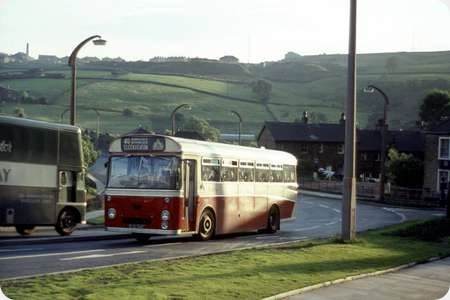
![0025037cejR1OBP[2] 0025037cejR1OBP[2]](http://www.old-bus-photos.co.uk/wp-content/uploads/2017/06/0025037cejR1OBP2_thumb.jpg)
![0034022cejR1OBP[2] 0034022cejR1OBP[2]](http://www.old-bus-photos.co.uk/wp-content/uploads/2017/06/0034022cejR1OBP2_thumb.jpg)
